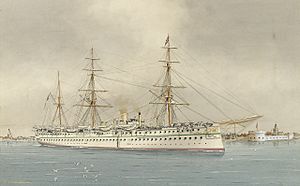HMS Serapis (1866) facts for kids
 |
|
Quick facts for kids History |
|
|---|---|
| Name | HMS Serapis |
| Ordered | 1865 |
| Builder | Thames Shipbuilding Co., Leamouth, London |
| Yard number | 12F |
| Launched | 26 September 1866 |
| Commissioned | 2 October 1876 at Portsmouth |
| Fate | Sold 23 November 1894 |
| General characteristics | |
| Class and type | Euphrates-class troopship |
| Type | Troopship |
| Displacement | 6,211 tons, 4,206 tons BM |
| Length | 360 ft (109.7 m) (overall) |
| Beam | 49 ft 1.5 in (15.0 m) |
| Depth of hold | 22 ft 4 in (6.81 m) |
| Installed power |
|
| Propulsion |
|
| Sail plan | Barque |
| Speed | 14 kn (26 km/h) |
| Armament | Three 4-pounder guns |
HMS Serapis was a special kind of ship called a Troopship. Her main job was to carry soldiers and their families to and from India. She was built in London and launched on September 26, 1866. Serapis was the third ship in the Royal Navy to have this name. She was sold in 1894 after many years of service.
Contents
Ship Design and Features
Serapis was one of five ships in a group called the Euphrates class. All these ships were made of iron. They were about 360 feet long and 49 feet wide.
These ships had:
- A single propeller to move them through the water.
- A top speed of about 14 knots (which is around 26 kilometers per hour).
- One tall funnel for smoke from the engine.
- Sails, like a Barque, to help them move when there was wind.
- Three small 4-pounder guns for defense.
- A white hull (the main body of the ship).
Serapis also had a special "ram bow". This part of the ship's front stuck out underwater, like a ram.
Life at Sea: Serapis's Journey
Serapis spent her whole career traveling between the United Kingdom and India. Each trip usually took about 70 days.
When she was first built, Serapis had a special 4-cylinder engine. But in 1869, this engine was changed to a simpler 2-cylinder engine. Even with the change, her speed stayed about the same, around 14 knots.
During her time at sea, Serapis had a few interesting events:
- In 1871, her main shaft broke. Another ship, Diomed, helped tow her. Later, HMS Crocodile took over and towed Serapis to Port Said, Egypt.
- In 1872, she got stuck in the Suez Canal but was freed two days later.
- In 1873, she accidentally hit a French schooner (a type of sailing ship) in the Indian Ocean. The schooner sank, and one crew member was lost. Serapis rescued the others.
- Later that year, she bumped into another ship, Paladine, near Malta. Paladine was badly damaged, but Serapis only had minor damage.
Royal Passenger and Other Events
In September 1875, Serapis had a very important passenger: the Prince of Wales (who later became King Edward VII). She took him to India for a big celebration. This was when Queen Victoria was named Empress of India.
In 1884, the ship's captain, Arthur Dupuis, was suspended after Serapis ran aground (got stuck on the seabed) off Portland. In 1886, she became part of a training group for ships in India. Later that year, she ran aground again near Southsea, Hampshire, but was pulled free by tugboats.
End of Service
Serapis was sold on November 23, 1894. Her sister ship, Euphrates, was sold at the same time.
How to Tell Her Apart
All five ships in the Euphrates class looked very similar. To tell them apart, each ship had a different colored band on its hull. Serapis had a green hull band.

